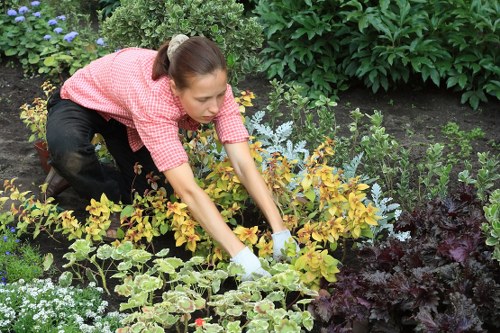Tree Lopping and Removal in Poplar
Understanding Poplar Trees

Poplar trees are renowned for their rapid growth and striking appearance, making them a popular choice in both urban and rural landscapes. However, their fast-paced growth can sometimes lead to structural weaknesses, necessitating professional tree lopping and removal.
Poplars belong to the Salicaceae family and are characterized by their tall stature, broad leaves, and distinctive catkins. Their adaptability to various soil types and climates further contributes to their widespread presence.
Despite their many advantages, poplar trees can present challenges such as susceptibility to diseases, extensive root systems that may interfere with infrastructure, and potential safety hazards when they become overgrown or damaged.
When to Consider Tree Lopping

Deciding to lop a poplar tree involves assessing its health, structural integrity, and impact on the surrounding environment. Here are key indicators that tree lopping might be necessary:
- **Health Issues:** Signs of disease, pest infestations, or significant damage.
- **Structural Weakness:** Weak branches or a compromised trunk that poses a risk of breaking.
- **Interference with Structures:** Roots or branches affecting buildings, sidewalks, or utility lines.
- **Safety Concerns:** Overgrown canopies that block visibility or obstruct pathways.
In such cases, professional assessment ensures that removal or lopping is the most effective solution.
Benefits of Professional Tree Removal

Engaging experts for tree removal ensures safety, efficiency, and compliance with local regulations. Professionals have the necessary equipment and expertise to handle complex removal tasks, minimizing risks to property and people.
Additionally, proper removal techniques help preserve the surrounding landscape and reduce environmental impact. Skilled arborists can also provide advice on suitable replacement trees, promoting a healthy and aesthetically pleasing environment.
Moreover, professional services often include cleanup and disposal, saving homeowners time and effort while ensuring responsible waste management.
Tree Lopping Techniques

Effective tree lopping involves various techniques tailored to the specific needs of the poplar tree and its environment:
- **Crown Thinning:** Removing select branches to reduce weight and improve airflow.
- **Crown Raising:** Eliminating lower branches to enhance clearance for vehicles or pedestrians.
- **Crown Reduction:** Shortening branches to control the tree's size while maintaining its natural shape.
- **Full Removal:** When a tree is beyond saving, complete removal may be the only option.
Each method requires careful planning and execution to ensure the tree's health is preserved as much as possible or to safely remove it without causing damage to the surrounding area.
Safety Precautions During Tree Removal

Safety is paramount during tree removal. Professionals adhere to strict safety protocols to prevent accidents and ensure a secure environment:
- **Proper Equipment:** Utilizing the right tools and machinery for the job.
- **Risk Assessment:** Evaluating potential hazards before commencing work.
- **Protective Gear:** Ensuring all workers wear appropriate safety gear.
- **Secure Area:** Establishing exclusion zones to keep bystanders safe.
Homeowners should never attempt to remove large trees without professional assistance, as the risks far outweigh the benefits.
Environmental Impact of Tree Removal

Removing trees, including poplars, has significant environmental implications. Trees are vital for carbon sequestration, oxygen production, and maintaining biodiversity. Therefore, it's essential to consider sustainable practices when planning tree removal:
Whenever possible, opt for selective pruning or lopping instead of complete removal. If removal is unavoidable, consider planting new trees to replace those lost, ensuring the continued health of the ecosystem.
Additionally, responsible disposal of tree materials, such as chipping and mulching, can reduce waste and support environmental conservation efforts.
Choosing the Right Tree Removal Service

Selecting a reputable tree removal service is crucial for ensuring quality work and peace of mind. Here are factors to consider:
- **Experience and Expertise:** Look for companies with a proven track record in handling poplar trees.
- **Licensing and Insurance:** Ensure the service is licensed and insured to protect against potential damages.
- **Customer Reviews:** Check testimonials and reviews to gauge customer satisfaction.
- **Transparent Pricing:** Obtain detailed estimates to avoid hidden costs.
- **Environmental Practices:** Choose services that prioritize eco-friendly methods.
Taking the time to research and select the right provider will lead to better outcomes and enhance the longevity of your landscape.
Post-Removal Care

After tree removal, proper maintenance is essential to restore and maintain your property’s aesthetics and safety:
- **Stump Grinding:** Removing the stump to prevent regrowth and eliminate tripping hazards.
- **Land Restoration:** Filling in holes and replanting grass or other vegetation to stabilize the soil.
- **Inspection:** Regularly inspecting the area for any signs of erosion or new growth.
- **Replacement Planting:** Consider planting new trees to replace those removed, ensuring to select species that complement your landscape.
These steps help maintain the beauty and functionality of your outdoor space while supporting environmental health.
Cost Factors in Tree Lopping and Removal

The cost of tree lopping and removal in poplar varies based on several factors:
- **Tree Size and Height:** Larger trees require more labor and equipment.
- **Tree Health:** Diseased or damaged trees may necessitate specialized removal techniques.
- **Accessibility:** Trees in hard-to-reach areas may increase costs.
- **Location:** Proximity to buildings, power lines, or other structures can affect pricing.
- **Additional Services:** Services like stump removal, hauling, and cleanup add to the overall cost.
Obtaining multiple quotes and understanding what each service includes can help you make an informed decision.
Regulations and Permits

Tree removal is often subject to local regulations and may require permits, especially for protected species or in designated areas. It’s essential to:
- **Check Local Laws:** Understand your municipality’s rules regarding tree removal.
- **Obtain Necessary Permits:** Ensure all required permits are secured before commencing work.
- **Comply with Environmental Standards:** Adhere to guidelines that protect local ecosystems.
- **Consult with Authorities:** Engage with local forestry or environmental departments for guidance.
Following legal requirements not only avoids fines but also contributes to responsible environmental stewardship.
Benefits of Timely Tree Maintenance

Regular tree maintenance can prevent the need for extensive lopping or removal. Benefits include:
- **Enhanced Tree Health:** Early detection and treatment of diseases or pests.
- **Improved Safety:** Reducing the risk of falling branches or structural failures.
- **Aesthetic Appeal:** Maintaining the desired shape and size for visual harmony.
- **Property Value:** Well-maintained trees can increase the value of your property.
- **Environmental Benefits:** Healthy trees continue to support biodiversity and climate regulation.
Investing in regular maintenance ensures the longevity and vitality of your poplar trees.
Eco-Friendly Tree Removal Practices

Adopting sustainable practices in tree removal minimizes environmental impact:
- **Recycling Wood:** Utilizing wood from removed trees for mulch, firewood, or construction materials.
- **Controlled Removal:** Ensuring minimal disruption to the surrounding ecosystem.
- **Replanting Efforts:** Planting native species to replace removed trees.
- **Reducing Waste:** Implementing efficient disposal methods to minimize landfill use.
- **Supporting Biodiversity:** Preserving habitats for local wildlife during removal processes.
These practices contribute to environmental conservation and promote a sustainable future.
Common Challenges in Poplar Tree Removal

Removing poplar trees presents unique challenges due to their growth characteristics:
- **Rapid Growth:** Leads to extensive root systems that can complicate removal.
- **Wood Density:** Can make cutting and processing more labor-intensive.
- **Height and Spread:** Tall, wide canopies require specialized equipment and techniques.
- **Proximity to Structures:** In urban areas, close neighbors and buildings impose limitations.
- **Environmental Regulations:** Strict guidelines may restrict removal processes.
Addressing these challenges requires expertise, proper planning, and resourcefulness.
Innovations in Tree Removal Technology

Advancements in technology have revolutionized tree removal, enhancing safety and efficiency:
- **Aerial Lifts and Cranes:** Allow access to difficult areas without extensive ground disruption.
- **Advanced Cutting Tools:** Improve precision and reduce time required for cutting.
- **Remote-Controlled Equipment:** Enhances operator safety by minimizing exposure to hazardous conditions.
- **Debris Management Systems:** Streamline cleanup and disposal processes.
- **Digital Planning Software:** Facilitates accurate assessment and planning for removal projects.
These innovations enable professionals to handle complex removal tasks more effectively, ensuring better outcomes.
Cost-Effective Tree Removal Strategies

Balancing cost with quality is essential in tree removal. Here are strategies to achieve cost-effectiveness:
- **Regular Maintenance:** Prevents the need for emergency removals, which can be more expensive.
- **Bundling Services:** Combining services like lopping, removal, and cleaning for discounts.
- **Seasonal Discounts:** Taking advantage of off-peak pricing.
- **Comparing Quotes:** Obtaining multiple estimates to find competitive pricing.
- **DIY for Small Trees:** Handling minor pruning tasks independently while leaving larger jobs to professionals.
Implementing these strategies can help manage expenses without compromising on quality.
Environmental Benefits of Poplar Trees

Despite the need for removal in some cases, poplar trees offer several environmental benefits:
They contribute to **carbon sequestration**, absorbing carbon dioxide and releasing oxygen, which is crucial for combating climate change. Their extensive root systems help **prevent soil erosion**, maintaining soil integrity. Additionally, poplars provide **habitats** for various wildlife species, supporting local biodiversity.
Respecting these benefits emphasizes the importance of thoughtful removal and replacement practices.
Legal Considerations in Tree Removal

Understanding the legal framework surrounding tree removal is essential to avoid penalties and ensure responsible practices:
- **Protected Species:** Some poplars may be protected by law, requiring special permissions for removal.
- **Property Boundaries:** Ensuring removal activities do not encroach on adjacent properties without consent.
- **Environmental Impact Assessments:** Conducting necessary evaluations for significant removal projects.
- **Contractual Agreements:** Having clear contracts with service providers outlining responsibilities and obligations.
- **Compliance Documentation:** Keeping records of permits, inspections, and other regulatory requirements.
Adhering to legal requirements fosters ethical practices and community trust.
Tree Health Assessment

Before deciding on tree lopping or removal, conducting a thorough health assessment is crucial:
- **Visual Inspection:** Checking for signs of disease, dead branches, or structural defects.
- **Soil Analysis:** Understanding soil health and its impact on tree vitality.
- **Root Examination:** Assessing the extent of the root system and any associated issues.
- **Growth Patterns:** Evaluating the natural growth and any deviations that may require intervention.
- **Professional Consultation:** Seeking advice from arborists or tree care specialists for accurate diagnosis.
Accurate assessments guide informed decisions, balancing tree preservation with necessary interventions.
Preventative Measures for Tree Health

Implementing preventative measures can extend the life of your poplar trees and reduce the need for drastic actions:
- **Proper Watering:** Ensuring adequate hydration, especially during dry periods.
- **Mulching:** Protecting roots and conserving soil moisture.
- **Pest Control:** Regularly monitoring and managing pest populations.
- **Pruning:** Removing dead or diseased branches to promote healthy growth.
- **Nutrient Management:** Providing necessary fertilizers to support tree health.
These practices contribute to robust and resilient trees, enhancing their longevity and reducing maintenance needs.
Impact on Property Value

Well-maintained trees, including poplars, can significantly enhance property value. They offer aesthetic appeal, provide shade, and create a welcoming environment. Conversely, neglected or hazardous trees can detract from property value and deter potential buyers.
Professional tree lopping and removal ensures that your landscape remains attractive and safe, positively influencing the overall perception and worth of your property.
Contact us today to schedule a consultation and enhance your property's landscape with our expert tree care services.

